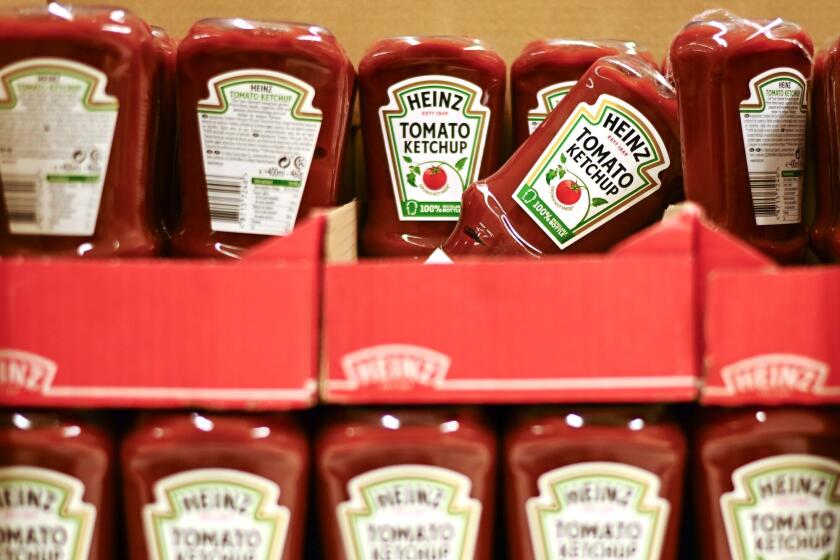
Salsa is ladled over a carnitas taco at Los Cinco Puntos, a Mexican corner grocery established in 1967.
(Ron De Angelis / For The Times)
18 immigrant-founded restaurants in L.A. from our Hall of Fame list
- Share via
Los Angeles is a mosaic of cultures, and nowhere is that more evident than within our local restaurant industry. Immigrants founded some of the city’s longest-running and most influential restaurants, including a bustling Vietnamese storefront in a San Gabriel strip mall, a legendary Nikkei spot that spawned a global restaurant empire and neighborhood taquerias where customers line up for the same signature item.
Gleaned from our growing Hall of Fame guide that honors the city’s timeless restaurants, here are 18 immigrant-founded restaurants to support in L.A.
Showing Places
Mariscos Jalisco
Boyle Heights Mexican Seafood $
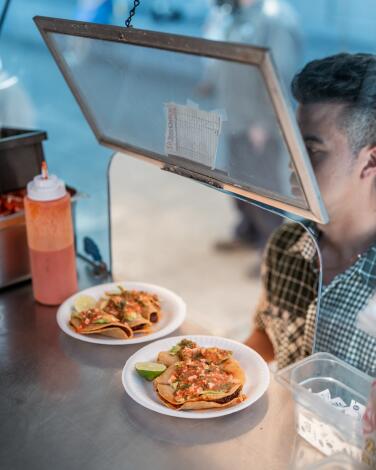
(Carter Hiyama / For The Times)
2024 Hall of Fame
Eating a pair of tacos dorados de camarones on the hood of your car while the salsa roja drips down your wrist is a quintessential Los Angeles dining experience. This is Southern California’s taco culture, wrapped up in three bites of Raul Ortega’s fried shrimp tacos. He started Mariscos Jalisco as a stationary food truck along Olympic Boulevard in 2001 with lime-slicked seafood and tacos inspired by the ones he ate in San Juan de los Lagos, Jalisco. More than two decades later, the Tostada Poseidon, a tower of shrimp soused in red aguachile over sliced octopus, is just as impressive. A sip of the coctel de camarón still carries the freshness of a seaside breeze. And the tacos dorados de camarones, which led to Ortega winning The Times’ 2024 Gold Award, continue to thrill me. Filled with chopped shrimp, then dropped into the fryer, the tacos are a study in contrasts. The shell remains blazing hot under the cool salsa and slivers of avocado. The bits of shrimp exposed to the frier are as crisp as the shell, frizzled and deeply browned. All the crunch collapses into a mouthful of soft, creamy shrimp filling. It is a constant in ever-uncertain times — an Angeleno’s taco North Star.
Eating a pair of tacos dorados de camarones on the hood of your car while the salsa roja drips down your wrist is a quintessential Los Angeles dining experience. This is Southern California’s taco culture, wrapped up in three bites of Raul Ortega’s fried shrimp tacos. He started Mariscos Jalisco as a stationary food truck along Olympic Boulevard in 2001 with lime-slicked seafood and tacos inspired by the ones he ate in San Juan de los Lagos, Jalisco. More than two decades later, the Tostada Poseidon, a tower of shrimp soused in red aguachile over sliced octopus, is just as impressive. A sip of the coctel de camarón still carries the freshness of a seaside breeze. And the tacos dorados de camarones, which led to Ortega winning The Times’ 2024 Gold Award, continue to thrill me. Filled with chopped shrimp, then dropped into the fryer, the tacos are a study in contrasts. The shell remains blazing hot under the cool salsa and slivers of avocado. The bits of shrimp exposed to the frier are as crisp as the shell, frizzled and deeply browned. All the crunch collapses into a mouthful of soft, creamy shrimp filling. It is a constant in ever-uncertain times — an Angeleno’s taco North Star.
Show more Show less
Route Details
Taste of Tehran
West Los Angeles Persian $$
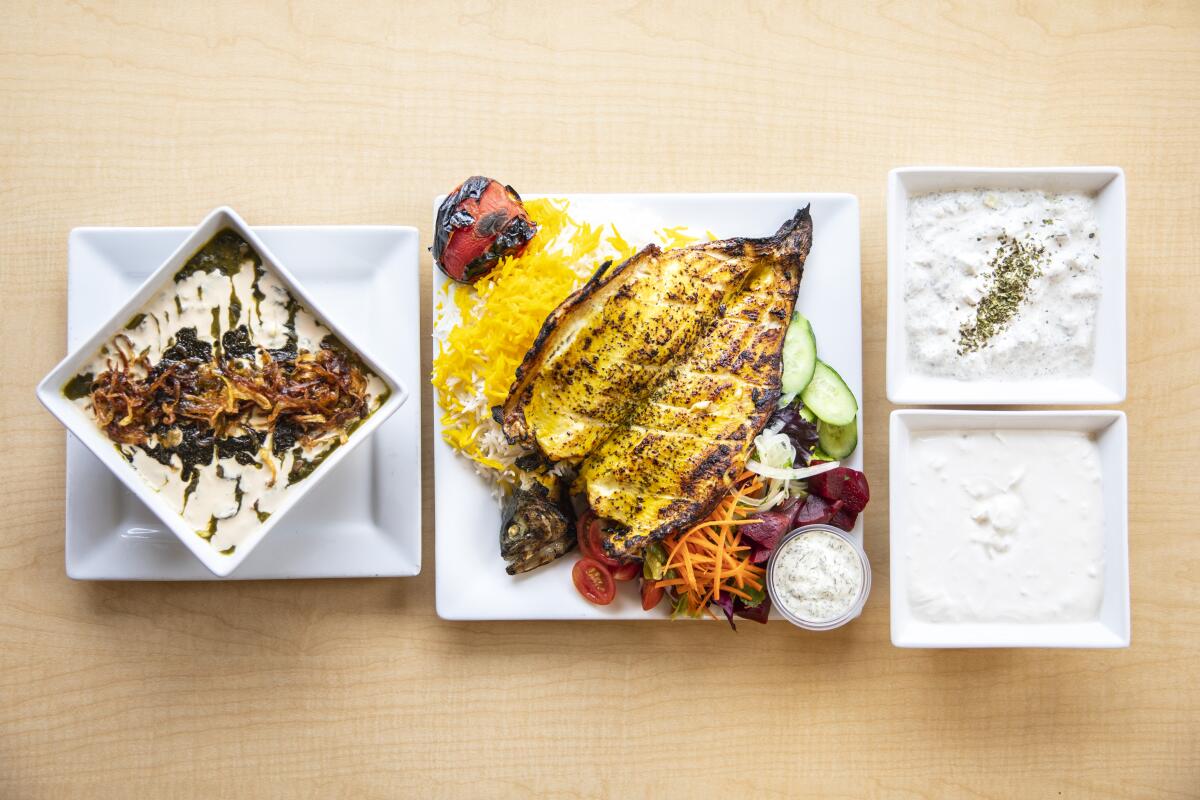
(Jay L. Clendenin / Los Angeles Times)
2024 Hall of Fame
A general rule of Persian cuisine in Los Angeles: The khoresht, or complex stew, is the fundament of Iranian home cooking, with infinite individual, regional and seasonal variations. (Local author Naz Deravian’s book “Bottom of the Pot” is one portal into the glories of khoresht.) Out in the world, families and groups tend to go out for kebabs, and restaurant dishes are designed for widespread appeal. Chef and owner Saghar Fanisalek’s six-table dining room may be hidden among the thicket of other Persian cafes and markets in Westwood, but Taste of Tehran stands out as the best of the kebab houses. Fanisalek cooks a reassuring mix of dishes — marinated meats singed over flames and served with snow banks of rice, yogurt and eggplant dips as tart as they are rich — all with uncommon finesse. Just the right amount of grated onion stings the beef koobideh, shaped in undulating patterns on the skewer, and the chicken kabob has fully absorbed its lemony marinade. Tahdig, that bottom-of-the-pot rice, cracks like crystal; order it with chicken fesenjoon spooned over and let its pomegranate-tinged gravy soften the grains for a few moments. On a warm day, try to claim one of the restaurant’s few tables along the well-trafficked sidewalk. You’ll be people-watching while passersby observe back, appraising your meal with ravenous glances.
A general rule of Persian cuisine in Los Angeles: The khoresht, or complex stew, is the fundament of Iranian home cooking, with infinite individual, regional and seasonal variations. (Local author Naz Deravian’s book “Bottom of the Pot” is one portal into the glories of khoresht.) Out in the world, families and groups tend to go out for kebabs, and restaurant dishes are designed for widespread appeal. Chef and owner Saghar Fanisalek’s six-table dining room may be hidden among the thicket of other Persian cafes and markets in Westwood, but Taste of Tehran stands out as the best of the kebab houses. Fanisalek cooks a reassuring mix of dishes — marinated meats singed over flames and served with snow banks of rice, yogurt and eggplant dips as tart as they are rich — all with uncommon finesse. Just the right amount of grated onion stings the beef koobideh, shaped in undulating patterns on the skewer, and the chicken kabob has fully absorbed its lemony marinade. Tahdig, that bottom-of-the-pot rice, cracks like crystal; order it with chicken fesenjoon spooned over and let its pomegranate-tinged gravy soften the grains for a few moments. On a warm day, try to claim one of the restaurant’s few tables along the well-trafficked sidewalk. You’ll be people-watching while passersby observe back, appraising your meal with ravenous glances.
Show more Show less
Route Details
Meals by Genet
Carthay Ethiopian $$

(Dania Maxwell / Los Angeles Times)
2023 Hall of Fame
In her semi-retirement, Genet Agonafer opens the elegant dining room of her Little Ethiopia stalwart for dinner Fridays through Sundays. The care in her food is as palpable as ever. Let’s never imagine a day without the restaurant’s doro wat, an indivisible sum of chicken, onions and profound berbere spices. Agonafer, who is vegan, creates a beautifully ordered landscape with her vegetarian platter: forest-green collards border earth tones of spiced lentils and split peas and marigold shades of turmeric-stained cabbage. Follow a similar path by adding an order of long-simmered foul warmed with green chile, or diverge with yebegsisga alitcha, a buttery and gently garlicky lamb stew.
In her semi-retirement, Genet Agonafer opens the elegant dining room of her Little Ethiopia stalwart for dinner Fridays through Sundays. The care in her food is as palpable as ever. Let’s never imagine a day without the restaurant’s doro wat, an indivisible sum of chicken, onions and profound berbere spices. Agonafer, who is vegan, creates a beautifully ordered landscape with her vegetarian platter: forest-green collards border earth tones of spiced lentils and split peas and marigold shades of turmeric-stained cabbage. Follow a similar path by adding an order of long-simmered foul warmed with green chile, or diverge with yebegsisga alitcha, a buttery and gently garlicky lamb stew.
Show more Show less
Route Details
Golden Deli
San Gabriel Valley Vietnamese $
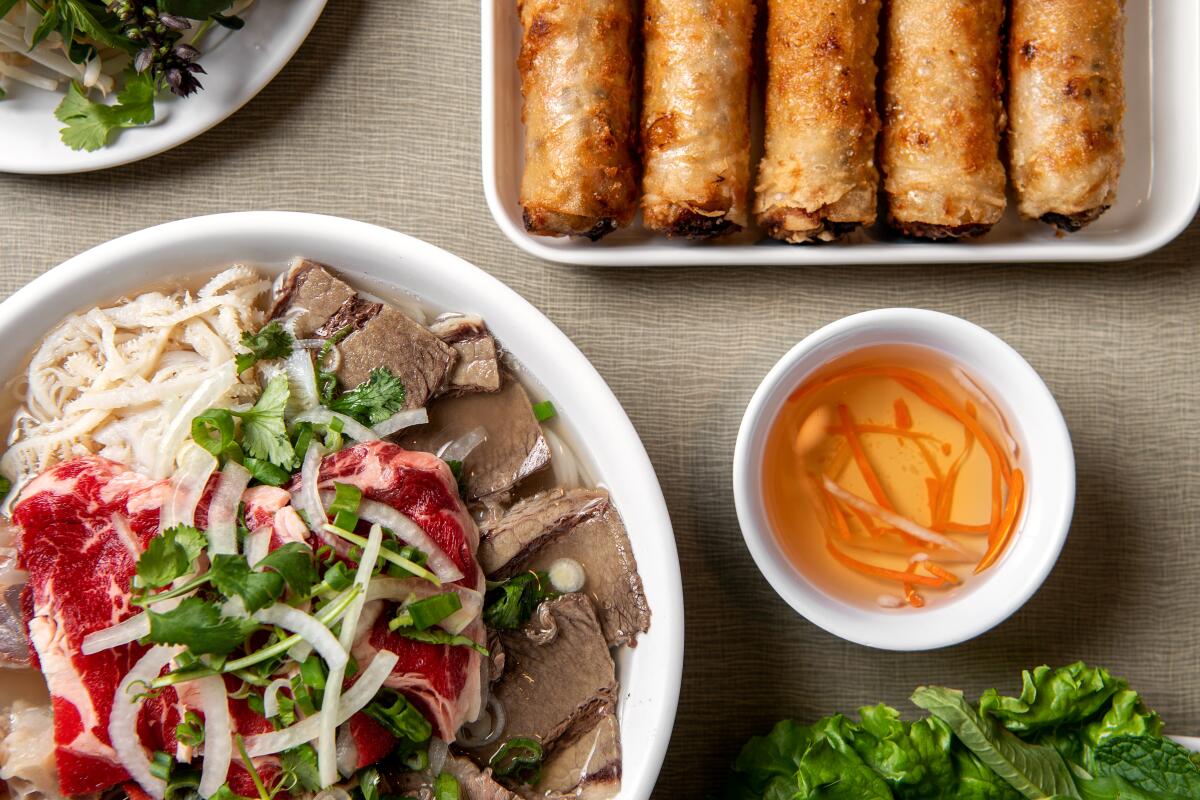
(Mariah Tauger / Los Angeles Times)
2023 Hall of Fame
These days the San Gabriel Valley is downright opulent with Vietnamese restaurants. Trieu and Lan Do laid the groundwork for the future riches in 1981, when they opened their first business in a San Gabriel strip mall. More than 40 years later, two things have stayed true: There will be a wait for a table (and the lounging chairs stationed outside along the sidewalk likely will be filled), and the room, whenever you are seated, will be filled with the audible crackling of cha gio. The craggy surface of the fried egg roll’s rice paper wrappers visually conveys “crunch” to the brain. Swaddling them in herbs and leaves only accentuates their texture. Golden Deli’s pho, skewered and grilled shrimp paste, banh mi and rice dishes are all dependable, but it is the cha gio for which you will return.
These days the San Gabriel Valley is downright opulent with Vietnamese restaurants. Trieu and Lan Do laid the groundwork for the future riches in 1981, when they opened their first business in a San Gabriel strip mall. More than 40 years later, two things have stayed true: There will be a wait for a table (and the lounging chairs stationed outside along the sidewalk likely will be filled), and the room, whenever you are seated, will be filled with the audible crackling of cha gio. The craggy surface of the fried egg roll’s rice paper wrappers visually conveys “crunch” to the brain. Swaddling them in herbs and leaves only accentuates their texture. Golden Deli’s pho, skewered and grilled shrimp paste, banh mi and rice dishes are all dependable, but it is the cha gio for which you will return.
Show more Show less
Route Details
Soban
Koreatown Korean $$
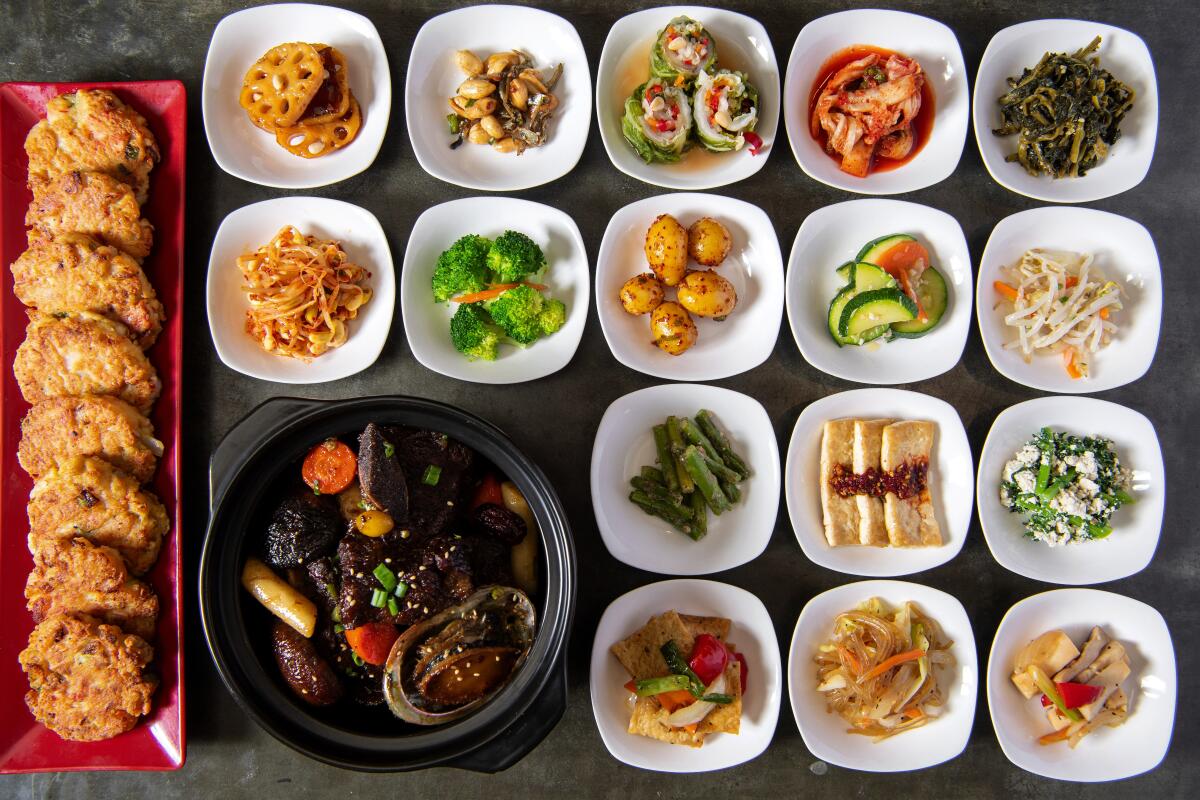
(Mariah Tauger / Los Angeles Times)
2024 Hall of Fame
Does the galbi jjim stew at Soban taste at least 18% better because chef-owner Jennifer Pak uses a pair of scissors to cut the chunks of short rib into bite-sized pieces at your table while telling your lunch date (in this case my mother) that she’s as beautiful as a movie star? Or because the wrinkled jujube dates at the bottom of the stew come from Pak’s own trees? Dining at Soban is mandatory eating for anyone attempting to understand the depth and breadth of Koreatown. The experience begins with an impressive array of the day’s banchan. There might be wood ear mushrooms dressed with sesame oil, a ramekin of japchae and a dish of crispy peanuts with baby anchovies you’d swear was the best bar snack in the world. Her ganjang gaejang come with plastic gloves so you can grasp the claws of raw, soy-marinated crab and suck the sweet meat out of the shell. I like to save the clumps of roe to eat with spoonfuls of hot purple rice. The braised black cod, cooked until the fish just starts to flake, is surrounded by big rounds of radish, potato, tteok and silken tofu. This is food and a place that never fails to comfort.
Does the galbi jjim stew at Soban taste at least 18% better because chef-owner Jennifer Pak uses a pair of scissors to cut the chunks of short rib into bite-sized pieces at your table while telling your lunch date (in this case my mother) that she’s as beautiful as a movie star? Or because the wrinkled jujube dates at the bottom of the stew come from Pak’s own trees? Dining at Soban is mandatory eating for anyone attempting to understand the depth and breadth of Koreatown. The experience begins with an impressive array of the day’s banchan. There might be wood ear mushrooms dressed with sesame oil, a ramekin of japchae and a dish of crispy peanuts with baby anchovies you’d swear was the best bar snack in the world. Her ganjang gaejang come with plastic gloves so you can grasp the claws of raw, soy-marinated crab and suck the sweet meat out of the shell. I like to save the clumps of roe to eat with spoonfuls of hot purple rice. The braised black cod, cooked until the fish just starts to flake, is surrounded by big rounds of radish, potato, tteok and silken tofu. This is food and a place that never fails to comfort.
Show more Show less
Route Details
Jitlada
East Hollywood Thai $$

(Mariah Tauger / Los Angeles Times)
2023 Hall of Fame
Few L.A. restaurant legends have endured like the story behind Jitlada: Chef Suthiporn “Tui” Sungkamee, who died in 2017, and his sister Sarintip “Jazz” Singsanong took over the long-running restaurant and introduced a then-untranslated back page full of radically spicy southern Thai specialties. Those dishes eventually were incorporated into the 10-page English menu, but their written accessibility doesn’t mean their incandescence has diminished. Some suggestions for jumping in: khua kling phat lung, a turmeric-stained beef curry; a salad of fried morning glory, plated so the stems look like they’re creeping over the edge of the bowl; and jungle curry with lamb, so ferocious with capsicums that the experience borders on supernatural possession. As a masterclass in regional Thai cooking, Jitlada is indispensable.
Watch more about Jitlada’s story.
Few L.A. restaurant legends have endured like the story behind Jitlada: Chef Suthiporn “Tui” Sungkamee, who died in 2017, and his sister Sarintip “Jazz” Singsanong took over the long-running restaurant and introduced a then-untranslated back page full of radically spicy southern Thai specialties. Those dishes eventually were incorporated into the 10-page English menu, but their written accessibility doesn’t mean their incandescence has diminished. Some suggestions for jumping in: khua kling phat lung, a turmeric-stained beef curry; a salad of fried morning glory, plated so the stems look like they’re creeping over the edge of the bowl; and jungle curry with lamb, so ferocious with capsicums that the experience borders on supernatural possession. As a masterclass in regional Thai cooking, Jitlada is indispensable.
Watch more about Jitlada’s story.
Show more Show less
Route Details
Kareem's Restaurant
Mediterranean $$
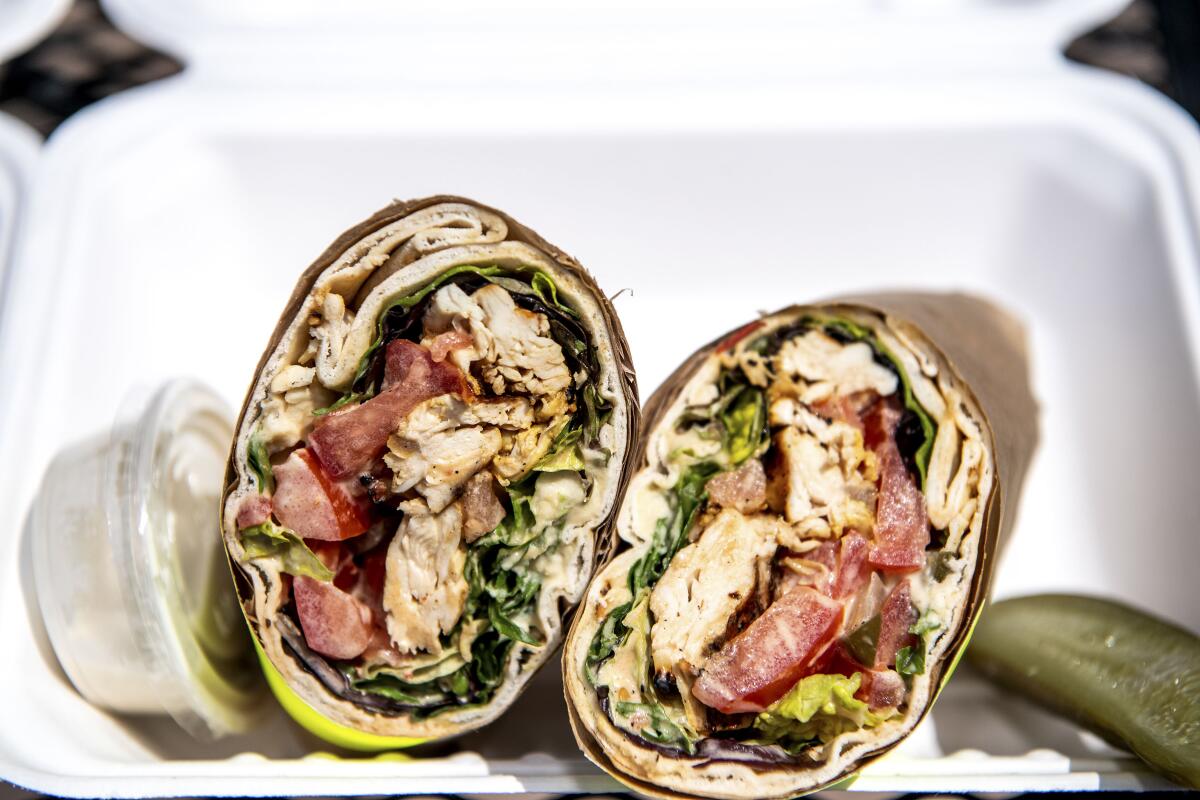
(Mariah Tauger / Los Angeles Times)
2023 Hall of Fame
Kareem’s, the Palestinian restaurant established by Mike Hawari and Nesrine Omari in 1996, technically sits just outside the mile-long stretch of Brookhurst Street that the Anaheim City Council designated as “Little Arabia” in summer 2022 after decades of lobbying. But the family business, now run by siblings Kareem Hawari and Nora Hawari, has long felt like a spiritual center of the neighborhood. Settle into a table on the plant-filled oasis of a patio for sustaining feasts of hummus, grape leaves, kebabs threaded with chicken and ground lamb and beef, minted yogurt with cucumber — and definitely falafel, crackly on the outside with an interior dyed spring-flush green from plenty of chopped parsley.
Kareem’s, the Palestinian restaurant established by Mike Hawari and Nesrine Omari in 1996, technically sits just outside the mile-long stretch of Brookhurst Street that the Anaheim City Council designated as “Little Arabia” in summer 2022 after decades of lobbying. But the family business, now run by siblings Kareem Hawari and Nora Hawari, has long felt like a spiritual center of the neighborhood. Settle into a table on the plant-filled oasis of a patio for sustaining feasts of hummus, grape leaves, kebabs threaded with chicken and ground lamb and beef, minted yogurt with cucumber — and definitely falafel, crackly on the outside with an interior dyed spring-flush green from plenty of chopped parsley.
Show more Show less
Route Details
La Casita Mexicana
Bell Mexican $$

(Ricardo DeAratanha / Los Angeles Times)
2023 Hall of Fame
Jaime Martin del Campo and Ramiro Arvizu — who were both born in Jalisco, Mexico, and met in the 1990s in Los Angeles when they were executives at competing airlines — opened their Bell restaurant in 1999. With a menu crafted partly as a tribute to their grandmothers, highlighting sophisticated, labor-intensive dishes from various regions of Mexico, La Casita Mexicana blurred genres. Was it a neighborhood restaurant? A place that leaned to special occasions? It didn’t need a set label, and it became an institution. Their chile en nogada, with a ground beef stuffing that includes candied cactus and a snowy pecan cream sauce scattered with pomegranate seeds, has been legendary for years. Breakfast is a destination unto itself; follow the crowd and order a plate of the tricolor chilaquiles divorciados.
Jaime Martin del Campo and Ramiro Arvizu — who were both born in Jalisco, Mexico, and met in the 1990s in Los Angeles when they were executives at competing airlines — opened their Bell restaurant in 1999. With a menu crafted partly as a tribute to their grandmothers, highlighting sophisticated, labor-intensive dishes from various regions of Mexico, La Casita Mexicana blurred genres. Was it a neighborhood restaurant? A place that leaned to special occasions? It didn’t need a set label, and it became an institution. Their chile en nogada, with a ground beef stuffing that includes candied cactus and a snowy pecan cream sauce scattered with pomegranate seeds, has been legendary for years. Breakfast is a destination unto itself; follow the crowd and order a plate of the tricolor chilaquiles divorciados.
Show more Show less
Route Details
Park's BBQ
Koreatown Korean $$$
2020
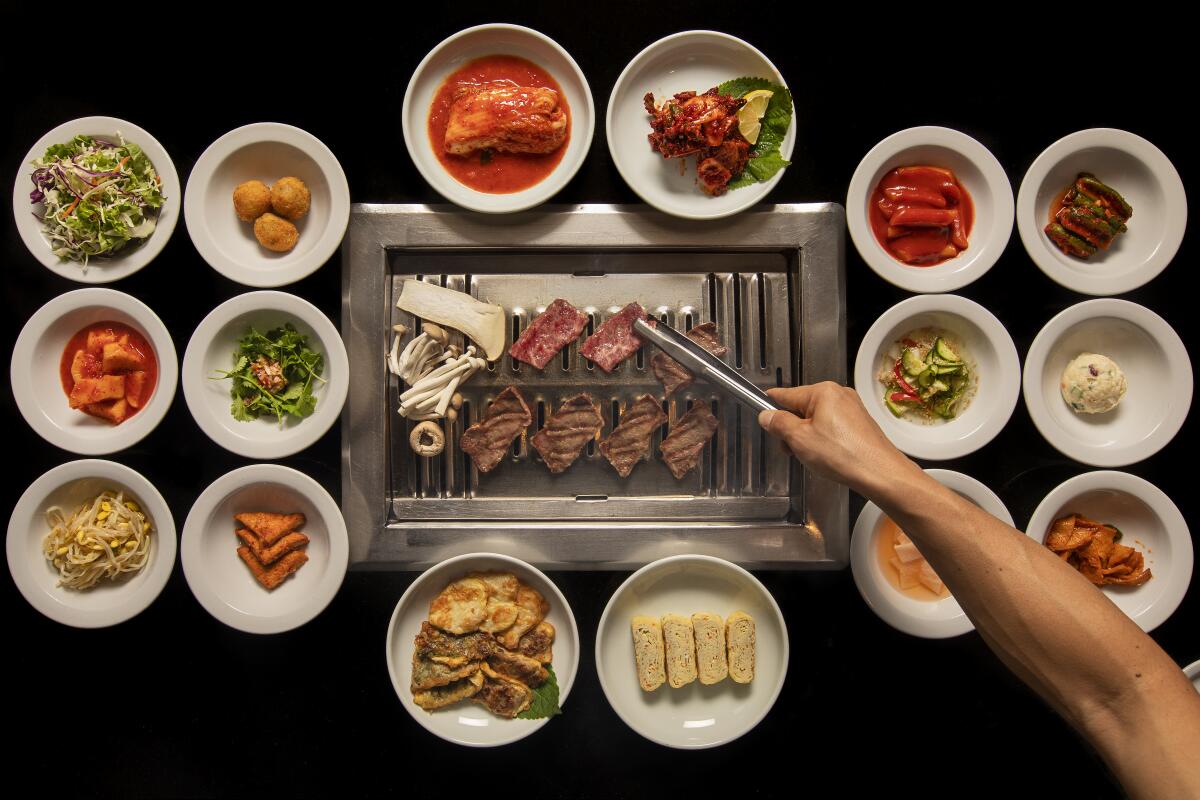
(Ricardo DeAratanha / Los Angeles Times)
2023 Hall of Fame
Literally dozens of barbecue houses line the streets of Koreatown. But for overall quality and hospitality, Jenee Kim’s operation has set the standard for decades. Come to Park’s with a group. A meal goes by in an exhilarating blur of fellowship and meat. The “Taste of Park’s” includes five cuts of beef: Deeply marbled ggot sal, hunks of short rib, tuiles of brisket, squiggles of bulgogi and a forearm-sized slab of galbi hit the tabletop grill in rapid sequence. A server comes and goes, turning the meats, cutting them with scissors and moving any remaining cooked bits to the side to make room for the next round. Maybe add cold noodles, or stone pot rice, or a seafood pancake? Depends on how much room you want to leave for more meat, or how much soju you’re drinking.
Literally dozens of barbecue houses line the streets of Koreatown. But for overall quality and hospitality, Jenee Kim’s operation has set the standard for decades. Come to Park’s with a group. A meal goes by in an exhilarating blur of fellowship and meat. The “Taste of Park’s” includes five cuts of beef: Deeply marbled ggot sal, hunks of short rib, tuiles of brisket, squiggles of bulgogi and a forearm-sized slab of galbi hit the tabletop grill in rapid sequence. A server comes and goes, turning the meats, cutting them with scissors and moving any remaining cooked bits to the side to make room for the next round. Maybe add cold noodles, or stone pot rice, or a seafood pancake? Depends on how much room you want to leave for more meat, or how much soju you’re drinking.
Show more Show less
Route Details
Al & Bea's
Boyle Heights Mexican $
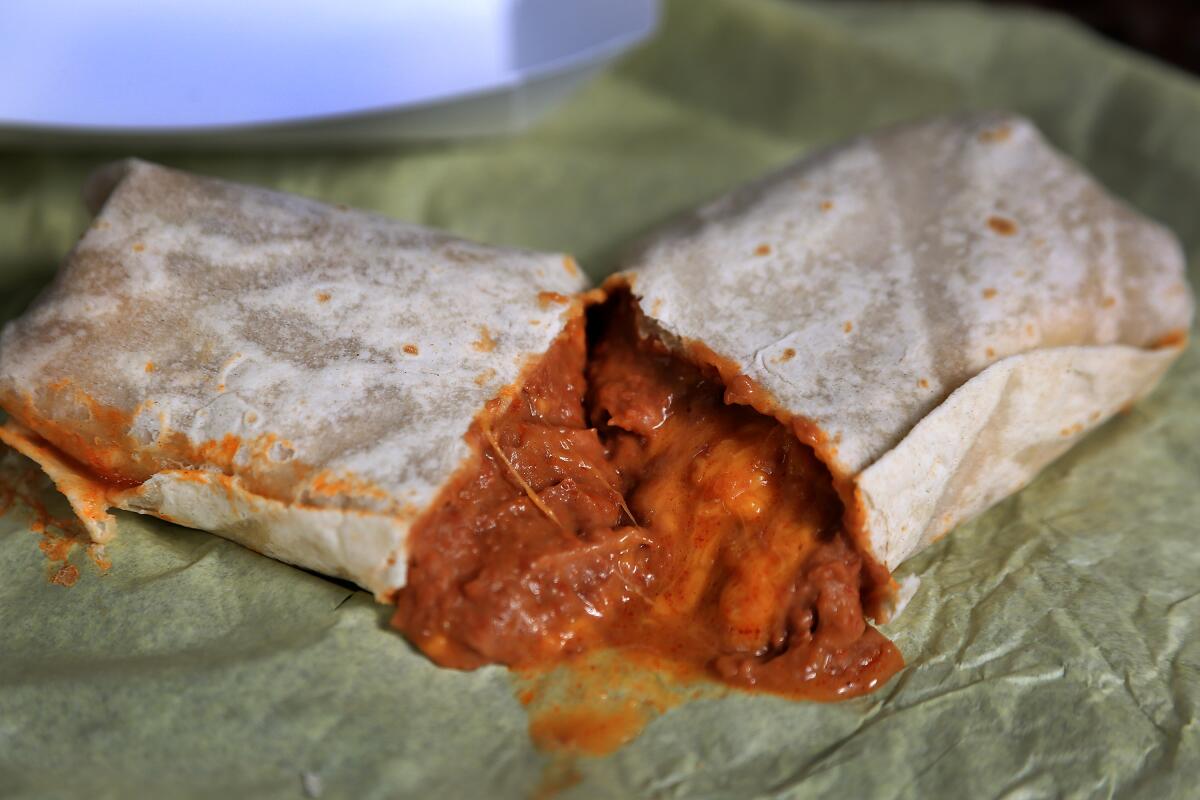
(Kirk McKoy / Los Angeles Times)
2022 Hall of Fame
Pick up a bean-and-cheese burrito at Al & Bea’s and it wobbles — sloshes, nearly — from the heft of its molten contents. You have a choice of red or green chile sauce; generations of fans have leaned green for its piercing zing. Albert and Beatrice Carreon opened their Boyle Heights stand on 1st Street in 1966; the business is now in the hands of their grandson, Albert Carreon. For either takeout or a quick meal at a shaded table, it remains a heart-of-the-community lunchtime destination for families and nearby workers.
Pick up a bean-and-cheese burrito at Al & Bea’s and it wobbles — sloshes, nearly — from the heft of its molten contents. You have a choice of red or green chile sauce; generations of fans have leaned green for its piercing zing. Albert and Beatrice Carreon opened their Boyle Heights stand on 1st Street in 1966; the business is now in the hands of their grandson, Albert Carreon. For either takeout or a quick meal at a shaded table, it remains a heart-of-the-community lunchtime destination for families and nearby workers.
Show more Show less
Route Details
Dan Sung Sa
Koreatown Korean
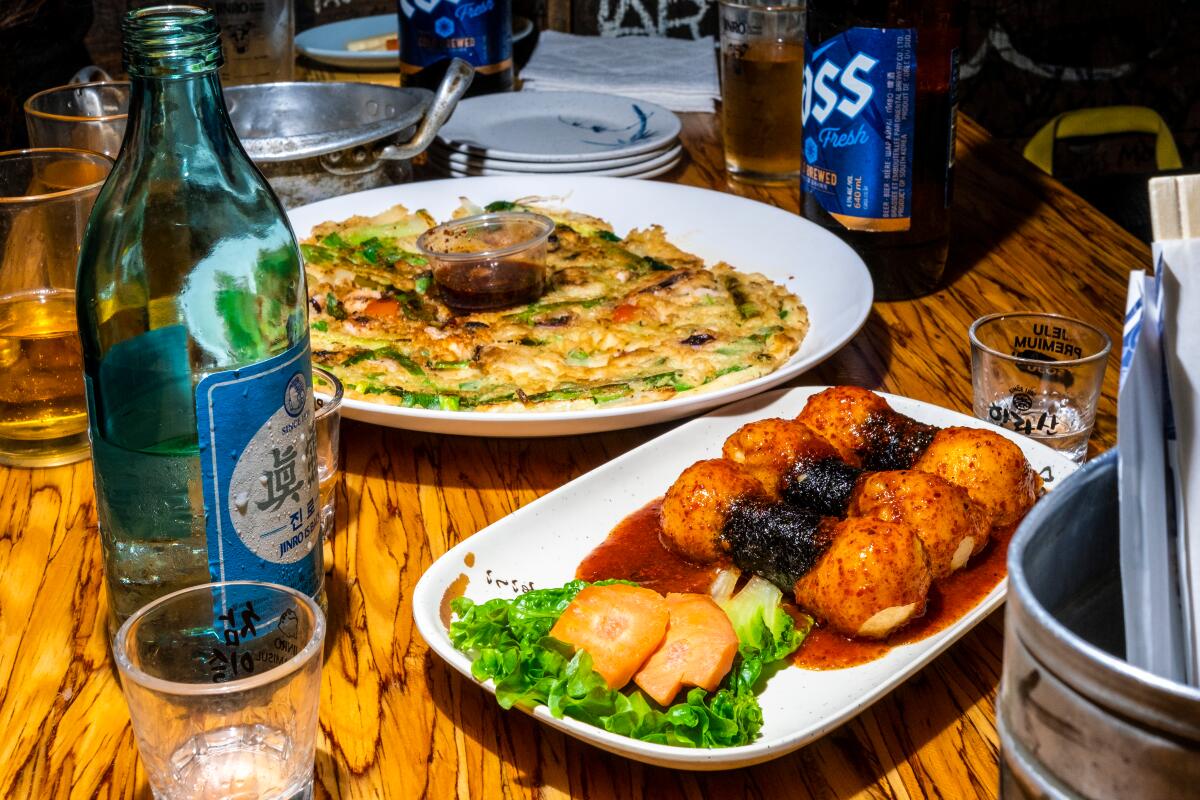
(Calvin B. Alagot / Los Angeles Times)
2022 Hall of Fame
Behind an inconspicuous wooden door in a Koreatown strip mall with a red brick façade, Caroline Cho runs one of L.A.’s iconic late-night haunts. She modeled the place in spirit after Korea’s tented pojangmacha street stalls, though Dan Sung Sa has its own matchless character: wood-paneled walls gashed with graffiti; a central grill where cooks churn out skewered meats; and Gen X-era K-pop power ballads gushing from the speakers. If one were to compose one of those ideal one-day itineraries for understanding Los Angeles, the night should arguably end here with rounds of soju and a snack of the seaweed-wrapped fried dough known as dumbbells.
Behind an inconspicuous wooden door in a Koreatown strip mall with a red brick façade, Caroline Cho runs one of L.A.’s iconic late-night haunts. She modeled the place in spirit after Korea’s tented pojangmacha street stalls, though Dan Sung Sa has its own matchless character: wood-paneled walls gashed with graffiti; a central grill where cooks churn out skewered meats; and Gen X-era K-pop power ballads gushing from the speakers. If one were to compose one of those ideal one-day itineraries for understanding Los Angeles, the night should arguably end here with rounds of soju and a snack of the seaweed-wrapped fried dough known as dumbbells.
Show more Show less
Route Details
Guelaguetza
Harvard Heights Mexican Oaxacan $$
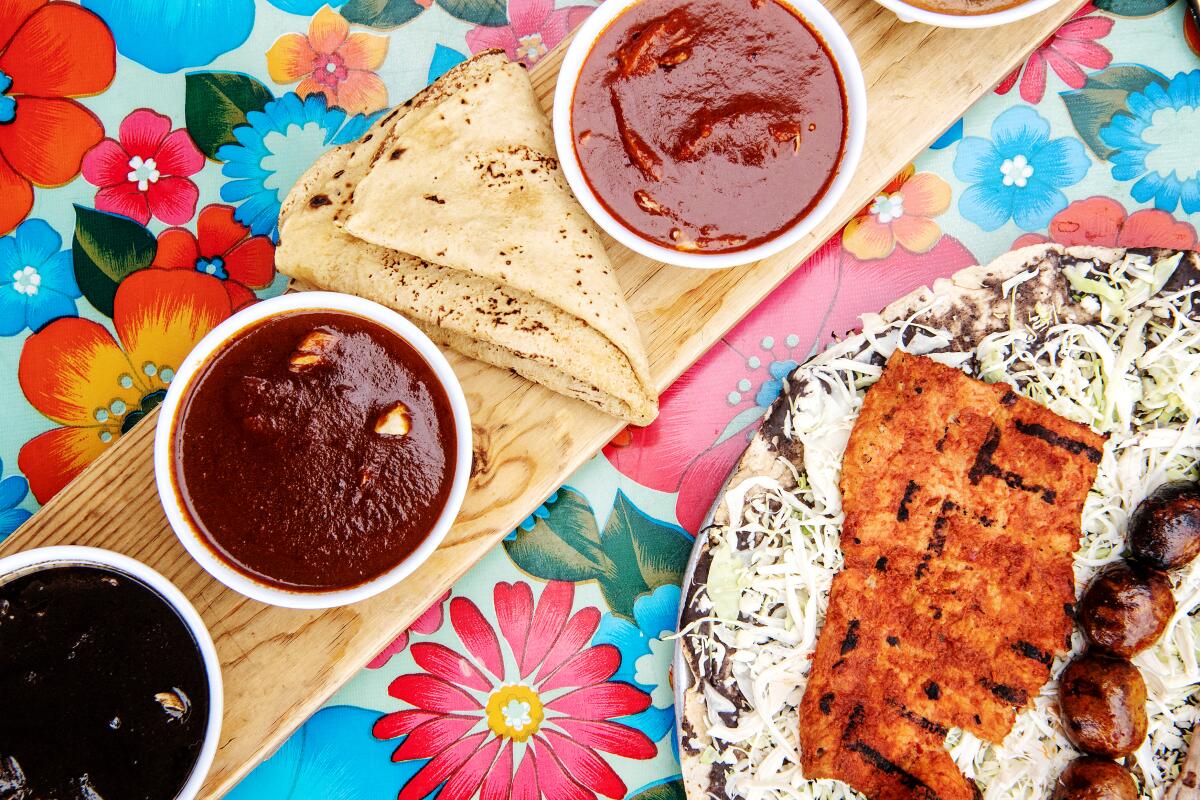
(Mariah Tauger / Los Angeles Times)
2022 Hall of Fame
At America’s most famous Oaxacan restaurant, founded by Fernando Lopez and now run by his family, the mole negro is as miraculous as ever — a composite of chiles, nuts, plantains, raisins, herbs and sweet and peppery spices merged into a hauntingly delicious whole. In the sprawling, color-splotched dining rooms, multigenerational families share tlayudas wreathed with strings of oval chorizo and barbacoa roja de chivo scented with avocado leaves. Guelaguetza is about more than dining, though. It stands as a stronghold of Oaxacalifornia, an example of achievement and unity in a region that has for decades been home to the largest Oaxacan population outside Mexico.
At America’s most famous Oaxacan restaurant, founded by Fernando Lopez and now run by his family, the mole negro is as miraculous as ever — a composite of chiles, nuts, plantains, raisins, herbs and sweet and peppery spices merged into a hauntingly delicious whole. In the sprawling, color-splotched dining rooms, multigenerational families share tlayudas wreathed with strings of oval chorizo and barbacoa roja de chivo scented with avocado leaves. Guelaguetza is about more than dining, though. It stands as a stronghold of Oaxacalifornia, an example of achievement and unity in a region that has for decades been home to the largest Oaxacan population outside Mexico.
Show more Show less
Route Details
Los Cinco Puntos
Boyle Heights Eatery

(Ron De Angelis / For The Times)
2022 Hall of Fame
Named for the points where East Cesar E. Chavez Avenue, Lorena Boulevard and Indiana Street meet in East L.A., the carnicería and Mexican corner grocery established in 1967 embodies the meaning of “intersection.” Something about the entwined smells in the air — meats simmering and frying, onions, lime juice, masa hitting the griddle — settles the psyche. No matter their errand, most customers walk out holding at least one taco made with a plush handmade corn tortilla. The standard taco choices can be repeated like a mantra: asada, carnitas, buche, lengua, pollo, chile rojo. First-time visitors should start with the carnitas.
Named for the points where East Cesar E. Chavez Avenue, Lorena Boulevard and Indiana Street meet in East L.A., the carnicería and Mexican corner grocery established in 1967 embodies the meaning of “intersection.” Something about the entwined smells in the air — meats simmering and frying, onions, lime juice, masa hitting the griddle — settles the psyche. No matter their errand, most customers walk out holding at least one taco made with a plush handmade corn tortilla. The standard taco choices can be repeated like a mantra: asada, carnitas, buche, lengua, pollo, chile rojo. First-time visitors should start with the carnitas.
Show more Show less
Route Details
Matsuhisa
Beverly Hills Japanese Sushi $$$$
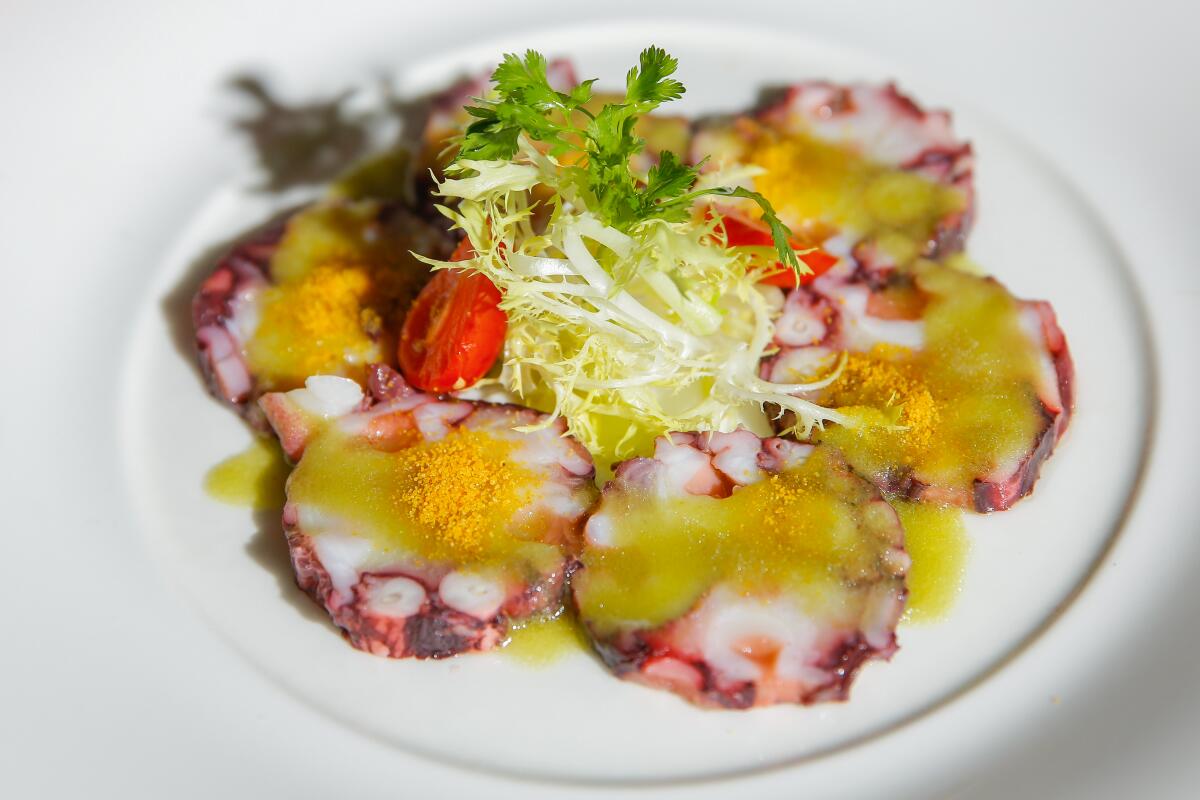
(Jay L. Clendenin / Los Angeles Times)
2022 Hall of Fame
How would sushi have evolved in Los Angeles without the arrival of Nobu Matsuhisa’s Beverly Hills restaurant in 1987? It would take a team of oral historians to unravel. He was born in Japan and cooked in Peru and other South American countries before opening Matsuhisa; its runaway popularity led to Nobu in New York and the chef’s ascent as a global brand. His menus have always been interlaced with Nikkei elements, most prominently in ceviches sparked with aji amarillo paste and citrus-drenched tiraditos. The spotlight on his bright, creamy, spicy creations also arguably fell on his time-honored presentations of nigiri. And might his success have also spurred local Japanese traditionalists to double down on serving more historically accurate sushi? In the end, Los Angeles has one of the world’s most energized and varied sushi cultures; plates of Matsuhisa’s ever-satisfying rock shrimp tempura or golden eye snapper with jalapeño salsa, followed by a tekkamaki, remind us where we’ve been and where we are now.
How would sushi have evolved in Los Angeles without the arrival of Nobu Matsuhisa’s Beverly Hills restaurant in 1987? It would take a team of oral historians to unravel. He was born in Japan and cooked in Peru and other South American countries before opening Matsuhisa; its runaway popularity led to Nobu in New York and the chef’s ascent as a global brand. His menus have always been interlaced with Nikkei elements, most prominently in ceviches sparked with aji amarillo paste and citrus-drenched tiraditos. The spotlight on his bright, creamy, spicy creations also arguably fell on his time-honored presentations of nigiri. And might his success have also spurred local Japanese traditionalists to double down on serving more historically accurate sushi? In the end, Los Angeles has one of the world’s most energized and varied sushi cultures; plates of Matsuhisa’s ever-satisfying rock shrimp tempura or golden eye snapper with jalapeño salsa, followed by a tekkamaki, remind us where we’ve been and where we are now.
Show more Show less
Route Details
Otafuku
Gardena Japanese $$$
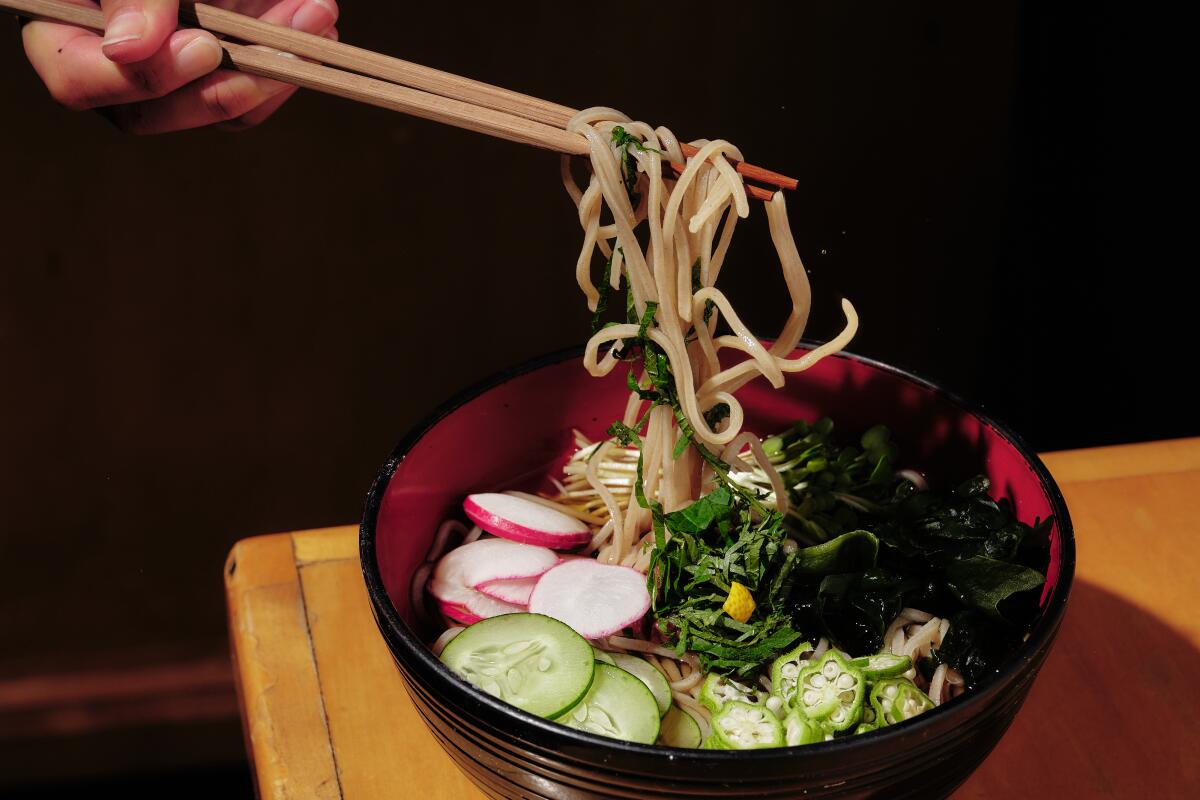
(Shelby Moore / For The Times)
2022 Hall of Fame
Very few restaurants serve fresh soba — with good reason. Buckwheat flour, the ingredient that gives soba its nutty snap, makes the dough notoriously difficult to form and cut. Seiji Akutsu has practiced the craft five days a week since he and his family opened Otafuku in 1997. He prepares the noodles in three variations, including one that is entirely buckwheat, though the most traditional (and arguably the best) is zaru soba with a ratio of 20% wheat. Try them both hot in soup and served cold on a woven bamboo mat with dipping sauce, and with a side of vegetable tempura. Gardena food lovers know what they have in the restaurant; a steady, easygoing crowd keeps the dining room full for lunch and dinner.
Very few restaurants serve fresh soba — with good reason. Buckwheat flour, the ingredient that gives soba its nutty snap, makes the dough notoriously difficult to form and cut. Seiji Akutsu has practiced the craft five days a week since he and his family opened Otafuku in 1997. He prepares the noodles in three variations, including one that is entirely buckwheat, though the most traditional (and arguably the best) is zaru soba with a ratio of 20% wheat. Try them both hot in soup and served cold on a woven bamboo mat with dipping sauce, and with a side of vegetable tempura. Gardena food lovers know what they have in the restaurant; a steady, easygoing crowd keeps the dining room full for lunch and dinner.
Show more Show less
Route Details
Phnom Penh Noodle Shack
Long Beach Cambodian $
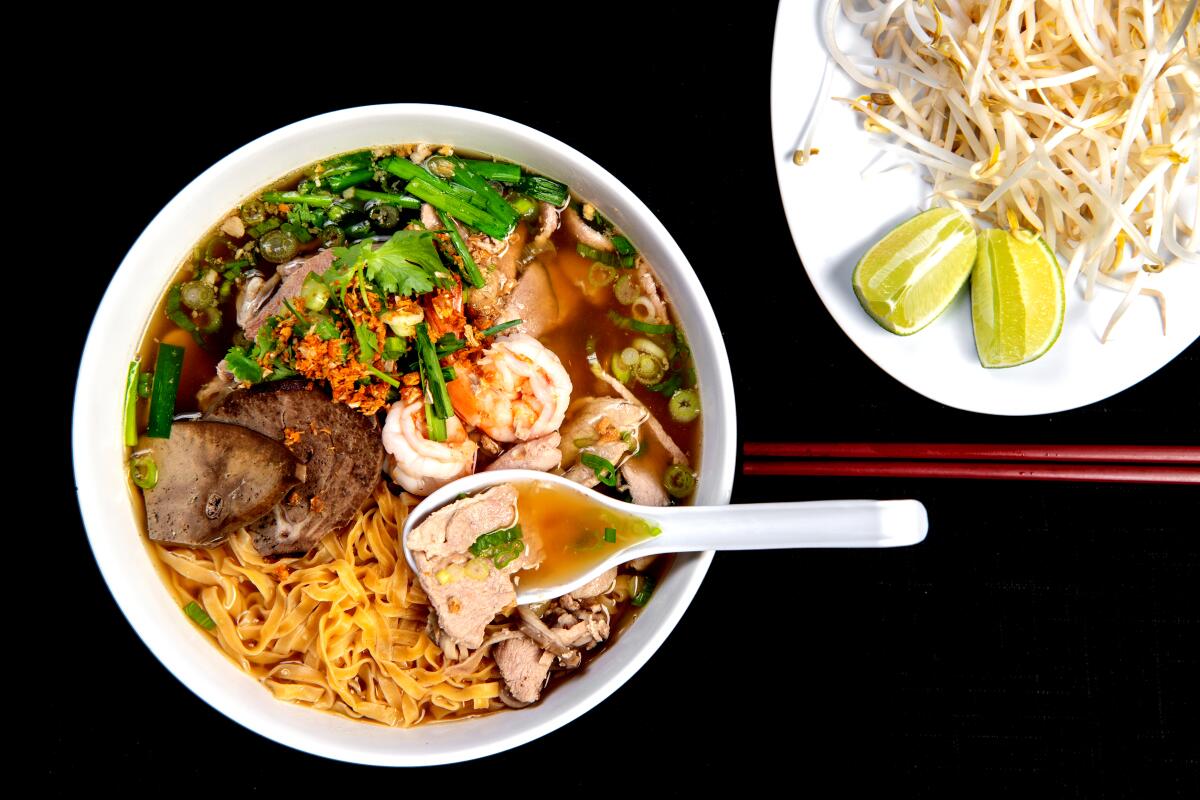
(Mariah Tauger / Los Angeles Times)
2022 Hall of Fame
Any conversation around the dining culture in Long Beach’s thriving Cambodian community begins with this restaurant opened by the Tan family in 1985. Kuy teav, the reason people wait mornings and afternoons for a table, is a highly customizable breakfast soup built around various shapes of rice or egg noodles and pork broth. The multitextured “house special” includes several cuts of pork and shrimp given even more nuance with the optional mixed noodles. Be generous with additions of fried garlic, scallions and squeezes of lime.
Any conversation around the dining culture in Long Beach’s thriving Cambodian community begins with this restaurant opened by the Tan family in 1985. Kuy teav, the reason people wait mornings and afternoons for a table, is a highly customizable breakfast soup built around various shapes of rice or egg noodles and pork broth. The multitextured “house special” includes several cuts of pork and shrimp given even more nuance with the optional mixed noodles. Be generous with additions of fried garlic, scallions and squeezes of lime.
Show more Show less
Route Details
Cielito Lindo
Downtown L.A. Mexican $
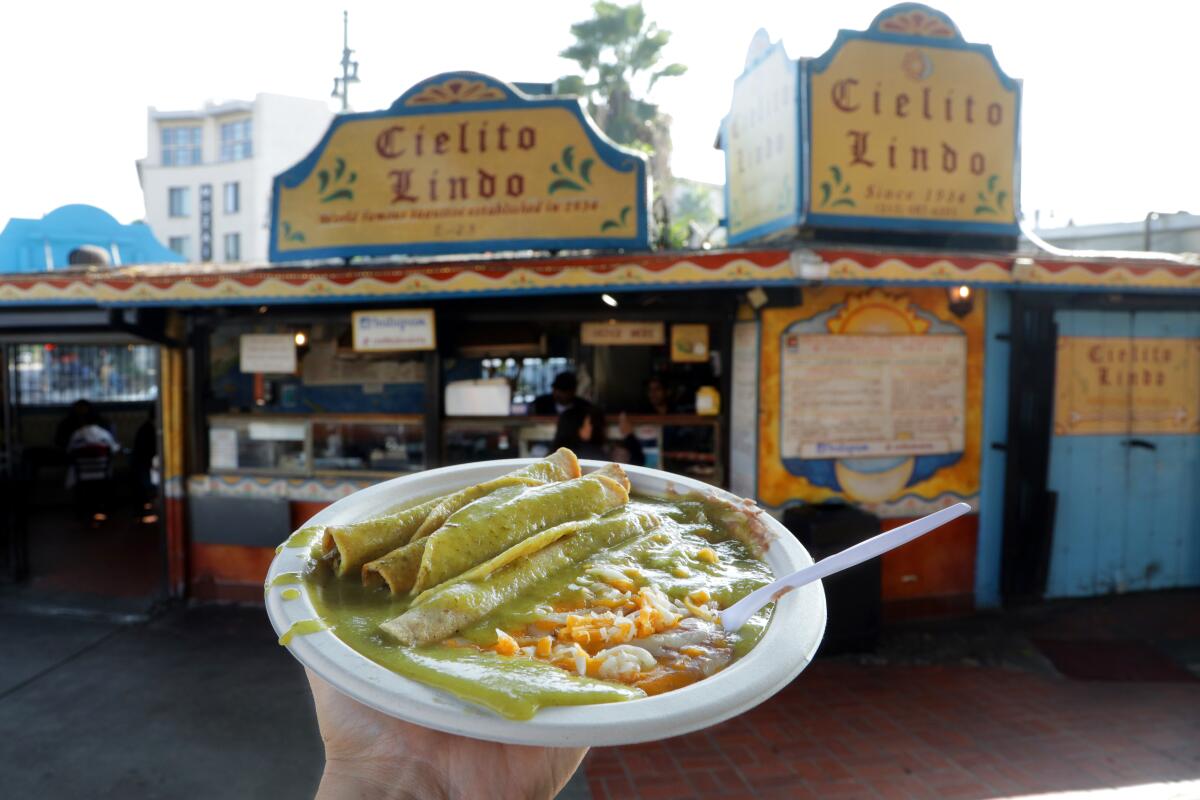
(Myung J. Chun / Los Angeles Times)
2019 Hall of Fame
The Olvera Street taqueria founded by Aurora Guerrero in 1934, who named her business after an 1880s-era song favored by mariachis, is known for one enduring specialty: beef taquitos, pan-fried in batches until the rolled tortillas seize into crispness. They come doused in mild tomatillo-based avocado sauce; the pleasure is in scarfing down the taquitos while they retain their crunch, even as the salsa begins to seep in and soften them. Guerrero’s granddaughter Diana Robertson carries on the family legacy with her sisters Mariana Robertson and Susanna MacManus. They operate a second takeout location at 1806 N. Broadway. Especially after the 2020 pandemic-related closures, though, it’s an easy joy to show up at the original location, stand in the fast-moving line and sit in one of two small dining areas that flank the stand’s counter. Taquitos weren’t designed to wilt in to-go containers.
The Olvera Street taqueria founded by Aurora Guerrero in 1934, who named her business after an 1880s-era song favored by mariachis, is known for one enduring specialty: beef taquitos, pan-fried in batches until the rolled tortillas seize into crispness. They come doused in mild tomatillo-based avocado sauce; the pleasure is in scarfing down the taquitos while they retain their crunch, even as the salsa begins to seep in and soften them. Guerrero’s granddaughter Diana Robertson carries on the family legacy with her sisters Mariana Robertson and Susanna MacManus. They operate a second takeout location at 1806 N. Broadway. Especially after the 2020 pandemic-related closures, though, it’s an easy joy to show up at the original location, stand in the fast-moving line and sit in one of two small dining areas that flank the stand’s counter. Taquitos weren’t designed to wilt in to-go containers.
Show more Show less
Route Details
Newport Seafood Restaurant
San Gabriel Valley Seafood Southeast Asian $$$

(Kathy M.Y. Pyon / Los Angeles Times)
2019 Hall of Fame
Wendy Lam and Ly Hua graft their Cambodian-Cantonese culinary roots with Vietnamese and Thai flavors for the sprawling menus at their two SGV restaurants. The union is best showcased in their famous spicy lobster, flamed in a wok’s inferno with garlic, ginger, jalapeños, green onions and black pepper. Their bo luc lac (Vietnam’s “shaking beef”) and steamed spot prawns are flawless in their simplicity. Go early or late, especially on weekends, to avoid long lines. Second location at 18441 E. Colima Road, Rowland Heights, (626) 839-1239.
Wendy Lam and Ly Hua graft their Cambodian-Cantonese culinary roots with Vietnamese and Thai flavors for the sprawling menus at their two SGV restaurants. The union is best showcased in their famous spicy lobster, flamed in a wok’s inferno with garlic, ginger, jalapeños, green onions and black pepper. Their bo luc lac (Vietnam’s “shaking beef”) and steamed spot prawns are flawless in their simplicity. Go early or late, especially on weekends, to avoid long lines. Second location at 18441 E. Colima Road, Rowland Heights, (626) 839-1239.
Show more Show less
Route Details
No matching entries.
Please reset filters to see all entries.
No matching entries.
Please reset filters to see all entries.
Top



